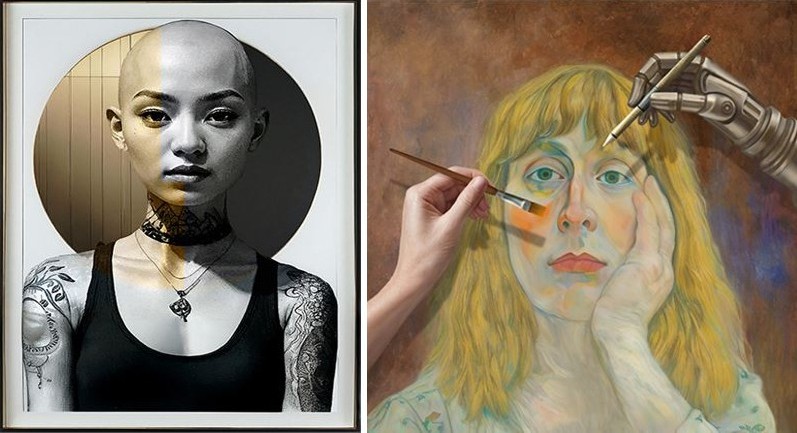When we were already making art, the digital world was still a novelty. Questions abounded on whether and how to incorporate this new tool into making art—something beyond the ordinary, something that would stand alongside traditional practices and materials. We were just beginning to see how computers could be a canvas.
Over the last two decades, we’ve watched this digital landscape evolve, embracing software and digital hardware as our tools. Now, here we are at another crossroads, faced with a technology that feels both familiar and entirely new: artificial intelligence.
The word “AI” brings up a lot of baggage. For many, it’s a source of fear—fear of replacement, of a loss of authenticity, of art becoming sterile and soulless. We’ve heard the critiques: AI art is plastic, predictable, and devoid of genuine emotion. Type a prompt, and presto, an image appears—lacking the sweat, the struggle, the slow, intentional dance of creation.
We acknowledge this critique because, on the surface, some of it feels true. There is a lot of formulaic, overly polished imagery out there. But to dismiss AI art is to miss the point entirely. It’s like rejecting photography because it’s not a painting or looking down on a lithograph because it’s not a sculpture. A new tool doesn’t erase the old ones; it simply gives us more ways to express ourselves.
For us and other artists, the images we generate with AI aren’t the final destination. They are a new kind of raw material. We think of them as a starting point—a piece of clay that needs to be shaped, a sketch that needs to be refined.
The most exciting part of this partnership is the surprise, the unexpected, the so-called “hallucinations” that AI produces. Where a programmer sees a bug, an artist sees an opportunity. In our work, we’ve always been drawn to the unseen, the surreal, and the beautifully strange. We’re not trying to capture reality in a factual sense; we’re working with fiction, with the world as it could be. And in this space, the illogical, distorted outputs of AI are a gift. They are seeds of new ideas.
We fold them into a partnering process, layering them with our photographs, drawings, and digital manipulations. It’s a slow, iterative dance—a back-and-forth between human intent and artificial ingenuity.
Consider the portrait. It has been explored extensively in digital space. With AI, that exploration can be deepened. The technology has become a collaborator, helping us push the boundaries of what a portrait can be. The final images aren’t just pixels; they are a conversation between the past and the present, the tangible and the intangible.
They hold the ghost of a photograph, the texture of a painting, and the otherworldly essence of something created by a machine.
The creative process has always been fluid. We rarely consider a piece truly “finished,” as there are always more possibilities, more variations to explore. AI only amplifies this, turning a single idea into a multitude of paths. We use it as a brainstorming partner, a “what if” machine that helps us flesh out new ideas.
Ultimately, we remain the authors—the ones making the choices, shaping the noise into a specific, intentional vision.
So, it’s time for a public exhibit to open minds and hearts to this new conversation. We invite you to contemplate these works as you would any other art—a watercolor, a sculpture, a photograph. Look at them not as the product of an algorithm, but as the result of a partnership, a collaboration between human passion and technological possibility.
Ask yourself the same questions you would of any other piece: Do they provoke something within you? Do they have emotional depth and intellectual appeal?
Our “Emergence” exhibit is not just a show about AI art; it’s a statement about the nature of art itself. It’s a reminder that artists have always used the resources available to them to push boundaries and create something new. This is simply the next step in that journey.
We believe the future of art lies not in a competition between humans and machines, but in the beautiful, strange, and wondrous space where they meet.
Consider a visit to “Emergence.” The exhibit will be at the Escondido Arts Partnership Expressions Gallery from Dec. 13 to Jan. 2. For more information, contact the gallery at 760-480-4101.
Joe Nalven and Jill Rowe are San Diego-based digital artists.
https://timesofsandiego.com/opinion/2025/10/25/ai-will-shape-future-of-art-time-public-to-see/

Be First to Comment